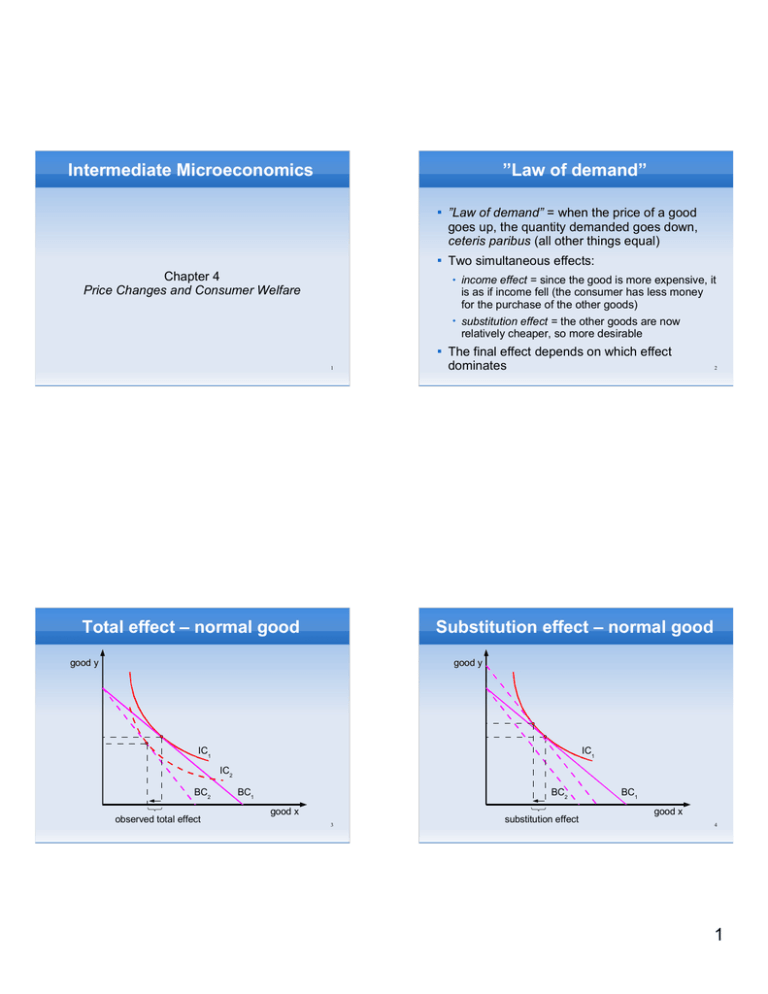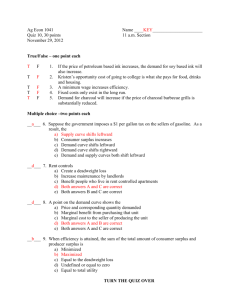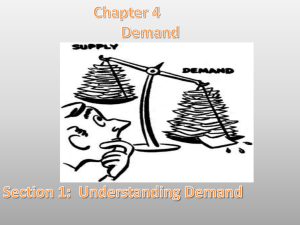Intermediate Microeconomics Law of demand goes up, the quantity demanded goes down,
advertisement

Intermediate Microeconomics Law of demand Law of demand = when the price of a good goes up, the quantity demanded goes down, ceteris paribus (all other things equal) Two simultaneous effects: Chapter 4 Price Changes and Consumer Welfare 1 Total effect normal good income effect = since the good is more expensive, it is as if income fell (the consumer has less money for the purchase of the other goods) substitution effect = the other goods are now relatively cheaper, so more desirable The final effect depends on which effect dominates 2 Substitution effect normal good good y good y IC1 IC1 IC2 BC2 observed total effect BC2 BC1 good x 3 substitution effect BC1 good x 4 1 Income effect normal good Substitution effect good y IC1 When price changes, suppose the consumer received some compensation that allowed her to achieve the same utility as before Substitution effect is the change in quantity demanded along the original indifference curve It is also called compensated response, because the consumer can still afford to be on the original indifference curve Always in opposite direction to the price change IC2 BC2 BC1 income effect good x 5 6 Income effect Types of goods When price changes, the consumer has more/less money for the other goods Normal good = both income and substitution effect work in the same direction Income effect is the change in quantity demanded as the consumer moves from the substitution effect point on the original indifference curve to the new indifference curve Inferior good = income effect and substitution effect work in opposite directions, but the substitution effect dominates (law of demand still holds) Depending on the type of good, it can work in the same direction or in the opposite direction to the price change Giffen good = income effect and substitution effect work in opposite directions, but the income effect dominates (law of demand fails) 7 8 2 Consumer surplus Consumer surplus (Marshallian) Consumer surplus = difference between what a consumer is willing to pay and what she actually has to pay Demand curve shows willingness to pay, so the height of a point is the marginal value of an additional unit of consumption at that point $ A p Demand curve So, area under the demand curve and above the price level is the consumer surplus Marginal effect of an additional unit B x Consumer surplus = A Total value of consuming x units = A + B 9 Effect of a price increase p2 p1 Trade quota = restriction on imports of some commodity When imposing a trade quota, the quantity available (supplied) is restricted price increases As a result, consumer surplus falls and consumers are worse off How about producers? They are better off because of higher prices (quota rents) But: deadweight loss (waste) society is worse off Loss in consumer surplus B Demand curve x2 x1 good X Initial consumer surplus = A + B Consumer surplus after price increase = A 10 Application: trade quotas $ A good X 11 12 3 Quota on imports $ D = Deadweight loss p2 p1 B Demand curve x2 x1 Loss in consumer surplus = C + D Quota rents = C good X 13 4





